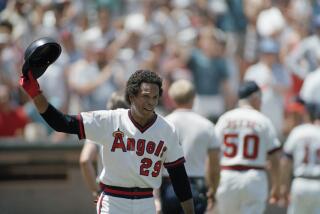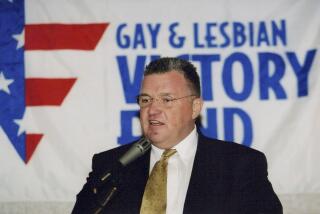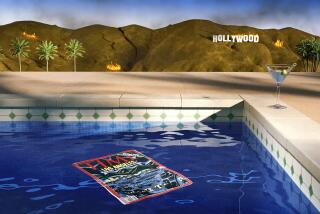How ‘Angels in America’ changed the national conversation
Queen Elizabeth called 1992 her annus horribilis. Bill Clinton defeated President George H.W. Bush and ended the Reagan era. Pope John Paul II lifted the Edict of Inquisition against Galileo, and the Toronto Blue Jays became the first non-American team to win the World Series. In April, a Simi Valley jury found four LAPD officers not guilty in the beating of Rodney King and Los Angeles exploded. In August, Pat Buchanan rocked the Republican convention with his infamous “God’s country” speech (“better in the original German,” observed columnist Molly Ivins).
Arching over the sociopolitical upheaval was the AIDS epidemic. By 1992, more than 1 million Americans were infected with HIV, and AIDS had killed close to 150,000 people, including Rock Hudson, Alvin Ailey, Robert Mapplethorpe, Isaac Asimov, Perry Ellis, Liberace, Michel Foucault and Ryan White. There was no cure or effective treatment in sight.
FOR THE RECORD:
“Angels in America”: A Nov. 11 Critic’s Notebook about the legacy of the play “Angels in America” 20 years later misspelled former Times editor Richard Rouillard’s last name as Rouille. —
Then, on Nov. 8, in a city still rebuilding from days of violent riots, “Angels in America: A Gay Fantasia on National Themes” opened at the Mark Taper Forum. There had been successful plays and films that positively depicted gay lives — “Torch Song Trilogy,” “La Cage aux Folles” — and later the devastation of AIDS with “The Normal Heart” and “Longtime Companion,” but nothing like “Angels in America,” which put AIDS into such heaving, glorious context that it finally and irrevocably became part of the national narrative.
GRAPHIC: Memories of ‘Angels in America’
“AIDS made it impossible not to talk about gayness,” says David Ehrenstein, a gay activist and author. “The grave wasn’t even a closet anymore. ‘Angels in America’ tied it into the huge arc of the American story; the gay community was no longer an isolated group. We needed a big play about this, and he gave us an epic — it was Brecht, it was Wagner. It was amazing.”
Theater is one way, one important way, we tell each other the stories of ourselves. Good theater deals in specifics that resonate with many, and it’s difficult to think of another play that told a story with such painful specificity and vast resonance. In “Angels in America” playwright Tony Kushner meticulously detailed the ghastly physical effects of AIDS and then shook his story so hard it unfurled to the edges of the universe — deep into history, high into the heavens.
Ehrenstein saw “Angels” with a group of friends in one go, a matinee performance of Part 1, “Millennium Approaches,” then an evening performance of Part 2, “Perestroika.”
“It was the only way to see it,” he says. “How could you stand to wait for the second part?”
Many early fans, including actor Alan Mandell, had waited two years to see the second part. In 1990, a friend persuaded him to see “Millennium Approaches” when it was in workshop at the Taper, Too. The Times’ theater critic, Sylvie Drake, had been less than effusive; though she admired the ambition of the work, she felt it was over-long. The result was a less-than-sold-out house.
FALL ARTS PREVIEW: Critic’s Picks
“[My friend] told me it was long, but it was worth it,” Mandell says now. “It was 31/2 hours, but it felt like 30 minutes. I remember after it was over, we just sat there, though we had been sitting for a very long time. We were just stunned by what we had seen. I would have sat through it again. That night.”
Instead Mandell, former consulting director at Los Angeles Theatre Center and general manager of the Repertory Theatre of Lincoln Center, got on the phone, calling actors, writers and anyone he could think of, telling them to see this play. “I don’t usually call people,” he says with a laugh. “But I told people I would buy their tickets if they would just go. I just couldn’t believe the scope of it — I had never seen a play about Mormons, and to put [Joseph McCarthy protégé] Roy Cohn in and make it so compelling. It was unbelievable.”
New York playwright and Oscar winner Mayo Simon, then living in Los Angeles, got one of those calls. “I asked Alan what it was about,” he says now. “And he said, ‘everything.’”
As Kushner finished the second half, “Millennium Approaches” went to London, where it became a bona fide hit. Presenting at the 1992 Tony Awards, Ian McKellen told audiences that when it came back to America, it would win every Tony there was. Simon went to the Taper and realized Mandell had been right.
“It was about the Jewish experience, the gay experience, McCarthyism, the Mormon experience. It was exploring a whole world of politics, feelings, religion. And it was about the AIDS experience, which was enormous and enormously scary — like a biblical plague. And,” he adds, “civic trumpets here, we all felt we were seeing it first.”
GRAPHIC: Memories of ‘Angels in America’
L.A. audiences no longer needed convincing. Twenty years later, it is, mercifully, difficult to recall those plague years when seemingly healthy men would cough suddenly and weeks later turn into lesion-plagued skeletons. But in 1992, a play about AIDS didn’t have much of a fourth wall; in Los Angeles County more than 11,000 people had died and one of every 200 was infected with HIV.
A two-part, seven-hour performance was a real commitment from someone with AIDS, but in those early audiences were men leaning on canes and the arms of nurses, a few wheeling oxygen tanks, many stifling beepers that told them it was time to take their medication. They came with their friends, with their partners, with fellow sufferers, or they came alone. As former Times editor Richard Rouille said, recalling his own memory of the premiere: “We were going to see that play if it was the last thing we did.” (He died four years later.)
AIDS had not only affected the lives of thousands of Angelenos, it had given new urgency to the gay rights movement. Kushner, who has gone on to write plays and screenplays about racism (“Caroline, or Change”), war (“Homebody/Kabul”), terrorism (“Munich”) and, most recently, the politics of slavery (“Lincoln”), said at the time that “Angels” was not just “an AIDS play.”
Though it spoke directly to many people’s reality, it also dismissed certain social and political definitions of reality itself. By sending an angel crashing through the ceiling or an unhappy woman into the Arctic, “Angels” questioned the validity of our self-imposed boundaries. When an AIDS sufferer in drag shares a hallucination with a Mormon wife, when the ghost of Ethel Rosenberg sings her nemesis to sleep, when angels turn to humans to lure back a distant God, the borders imposed by narrow-mindedness seem absurd indeed.
“What Kushner did,” Ehrenstein says, “was introduce the epidemic to a whole lot of people who weren’t paying attention. And for those of us who were, he gave us a whole new context.”
“I remember the nurse in ‘Angels,’” says Sasha Anawalt, associate professor of arts journalism at USC Annenberg School for Communication and Journalism, “who was so like the nurse at our friend Mark Locher’s bedside. Mark died of complications from AIDS, as we were taught to say. Kushner spoke to me of my own loss,” she adds, “but I knew it was bigger than that. I knew this play was bigger. Which told me we’d get past this.”
Despite its clear tether to a specific point in time, the play remains powerful and resonant. The themes of political divisiveness are depressingly applicable two decades later, its message regarding the shifting and often hallucinatory nature of religion as well as some of its humor is echoed in Broadway’s current darling “The Book of Mormon.”
“Angels” made a promise to the men in the audience who did not live to see the Tonys, seven of them, or the Pulitzer Kushner won, who never saw the many revivals including an opera and Mike Nichols’ Emmy Award-winning television adaptation, and to those who survived the years of funerals and hospital beds and night sweats, the fistful of pills, the endless dread: What happened to you mattered and will matter until the end of time.
But the play is not so much an elegy as a battle cry. “The great work begins,” the angel tells Prior at the end of Part 1. “The great work begins,” Prior agrees at the end of Part 2, speaking directly to the audience and to the generations. To Ron Nyswaner and Jonathan Demme, who created “Philadelphia”; to Jonathan Larson, who turned “La Bohème” into “Rent”; to Sapphire, who gave us the character of Precious; to the creators of “Queer as Folk,” “Will & Grace” and “The L Word”; to Ellen DeGeneres, Ryan Murphy and Neil Patrick Harris.
In Los Angeles in 1992, an angel crashed through the roof at the Mark Taper Forum and made a little more room in the world for everyone.
MORE
CRITIC’S PICKS: Fall Arts Preview
TIMELINE: John Cage’s Los Angeles
PHOTOS: Arts and culture in pictures
More to Read
The biggest entertainment stories
Get our big stories about Hollywood, film, television, music, arts, culture and more right in your inbox as soon as they publish.
You may occasionally receive promotional content from the Los Angeles Times.







